 Productivity ultimately relies on you, and me, what you do, what I do. Time management is an element of self-leadership.
Productivity ultimately relies on you, and me, what you do, what I do. Time management is an element of self-leadership.
Brian Tracy, famed self-development author and speaker, once wrote:
"Time management is really life management, personal management."
In organizational life, however, it’s also about the team. When you have projects and initiatives that you’re responsible for, most of the time, you’re responsible for some parts, and others are responsible for other parts. Right?
And so, it’s not just what you and I each do as individuals – it’s what the team does as well; How it interacts, how it works together, how it tracks its progress.
That’s where a scorebard comes in.
Keep a Scoreboard for the Team
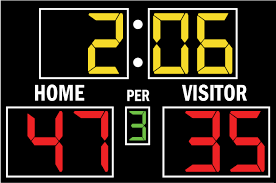
In sports – football, basketball, soccer, baseball, tennis – why do we keep a scoreboard?
First answer: To keep score.
Better answer: So we know whether we’re winning!
People want to win. It’s energizing. It’s motivating. There’s a difference in energy and focus when we’re playing a game for fun and when we’re really keeping score.
A scoreboard also helps us – as individual players AND as a team – adjust to the game as its being played. We MUST know the score; otherwise, we don’t know what to do, how to shift, where to focus…so we can ensure our chances of winning.
Here are three things to keep in mind as you think about developing scoreboards for yourself and with your team.
1. A Great Scoreboard is Simple
Simple means...we can look at it in a moment and know the score.
Too many scoreboards in business are way too complex to process easily. They’re buried away in spreadsheets and reports that require an advanced degree in analytics just to understand them. Keep it simple.
“Simple” is also a relative term. As Einstein said, “Everything must be made as simple as possible, but no simpler.”
You and your team need to determine what kind of scoreboard best conveys the progress of your team on projects and initiatives, while also being mindful of not making it so complex that it prevents you from knowing the score.
Below is a simple chart a client of mine uses:
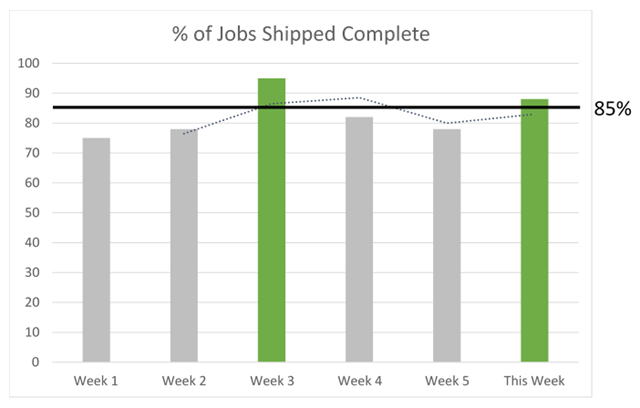
They’re a supplier to local home builders. One of their key measures is to ship at least 85% of their jobs to home sites complete – one trip.
The Industry average in their market is about 75% -- they want to stand out as a delivery leader. Plus, the more they ship jobs complete, the more they cut costs (because they don’t have multiple deliveries per site) and they increase efficiency within their operation (because multiple deliveries eat into production time).
At a glance, their simple scoreboard shows their weekly progress to the metric, as well as (via the trend line) the longer-term view of whether they’re winning.
2. A Great Scoreboard Operates in “Real-Time”
“Real-time” means two things:
- It’s updated regularly to show real-time results,
- it’s publicly available so team members can view it in real-time.
“Real-time” might mean your scoreboard is updated weekly at the very least, especially for longer-term projects and initiatives. But the more frequently you’re able to update the scoreboard and keep it in view for everyone to see, the more easily everyone can know the score.
My building supply client has this scoreboard posted at all times for the production team to see. It’s posted on a big board at the door where they enter and exit the shop. And the current week’s results are updated each morning to incorporate the delivery percentage from the day before and to show the team its weekly progress from the previous day.
That not only lets them know whether they’re winning – it creates awareness for them about what they need to be doing differently TODAY, and even for the rest of the week, to influence the numbers in the right direction.
Another crucial advantage of a real-time scoreboard: It focuses us on the LEADING INDICATORS that will bring us our desired results. Many times in business we focus on lagging indicators – the final measurables, the final scores. “Did we hit our number?”
But if we only focus on lagging indicators – rather than the inputs and the actions that move us toward it – by the time we get the data, the number, it’s too late. That’s like waiting to put up the score in a football game or soccer match only once the game is over.
Or it’s like me saying, “I’m going to lose 20 pounds in the next three months, but I’m going to weigh myself only once – at the end of three months. Boy, I hope I lose those 20 pounds.”
3. A Great Scoreboard Is For the Players
A scoreboard isn’t there so much for the coaches, the leaders; it’s there for the team, the players. That’s why it needs to be simple, publicly available, and updated regularly.
To have a scoreboard FOR the team, it’s also best if the scoreboard is created BY the team. Ask them: What kind of scoreboard will be useful for us to track progress, so we can always know the score and make adjustments along the way?
There are hundreds of ways of creating and presenting a scoreboard. It could be something like this…
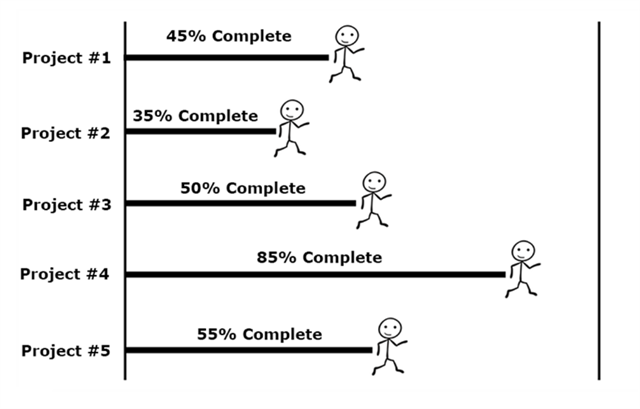
It could be a burn chart, as used in AGILE project management…
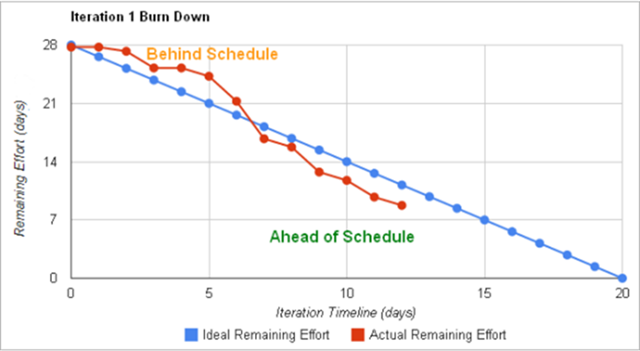
Or it could be a comparison chart like this one.
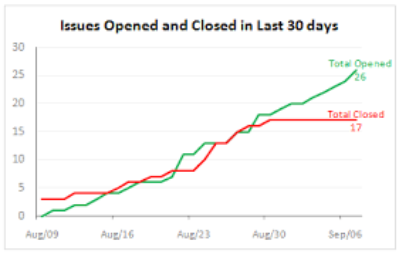
There are hundreds of ways you can do scoreboards. GOOGLE is a great place to get you and your team going.
Get your team together...isolate what the team needs to measure and track...then build your scoreboard together and start keeping score.
If you do it, you’ll enhance your team’s focus on what’s most important, and you’ll increase their winning ways.